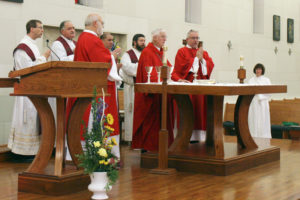By Anne Marie Amacher
The Catholic Messenger
DAVENPORT — In one year, the St. Thomas Aquinas Guild of the Quad Cities, a chartered guild of the Catholic Medical Association, has grown from a core of 14 physicians to more than 70 members. Those members are primarily in the medical field. Other members include priests, lawyers and other non-medical field supporters.

Bishop Martin Amos celebrates the White Mass Oct. 17 for medical professionals. Concelebrating were, from back, left, Msgr. Mark Merdian, pastor of St. Pius X Parish in Rock Island, Illinois; Father Chuck Adam, chaplain at St. Ambrose University in Davenport; Father Joseph Sia, pastor of St. Joseph Parish in Columbus Junction; and Father Paul Appel, in solidum at St. Peter Parish in Buffalo and St. Alphonsus and St. Mary parishes in Davenport. Also pictured are Deacon David Montgomery and Deacon John Wagner.
A White Mass for medical professionals was held Oct. 17 in Christ the King Chapel at St. Ambrose University. The guild is the only one in the U.S. that serves two dioceses, which happen to be in two different states. Bishop Martin Amos presided at the Mass with Fathers Chuck Adam, Paul Appel and Joseph Sia, all of the Diocese of Davenport, and Msgr. Mark Merdian of the Diocese of Peoria, Illinois, as concelebrants.
Bishop Amos described as “awesome” the health care community coming together for the White Mass. “It speaks to a realization of something, or better, someone beyond ourselves. The one who gives life itself, and to whom all life returns. The divine physician.” It is a realization of being part of God’s plan and that God uses health care providers as instruments of healing.
The bishop noted that this December he turns 74. “So when people ask me what I’m doing these days I say ‘collecting doctors.’” He listed those in the medical field who have helped him through knee replacement and back surgery: surgeons, visiting nurses, physical therapists and others. “We say it takes a village to raise a child. We might say the same thing about the health profession. It takes a village to heal a sick person.”
The White Mass recognizes those in the health care field, whatever their role, Bishop Amos noted. “You bear the privilege and the burden walking this holy ground, day after day (with the sick and dying). You are invited into the most intimate moments of people’s lives (joy, sorrow, anguish). You are even able to gaze intimately at the deepest of human mysteries (death and human frailty). … It is as much your calling to cure as it is to comfort and companion. Healing comes in many forms.”
Breakfast and a talk followed after Mass. Sister Mary Diana Dreger, OP, MD, spoke on “Hope: In Theory and in (Medical) Practice.” Hope has many meanings, she told the crowd, providing examples from the dictionary. “But the Christian understanding is a whole lot bigger.” She referred to Scripture passages from the Old Testament and New Testament that speak of hope.
Christian hope, Sr. Dreger said, is a theological virtue that the Lord is trustworthy, fulfills promises and relies on his strength. “It’s not up to me. Put your trust in the Lord to get there.” She noted that between despair and presumption is hope. Hope also is putting trust in oneself and in God. “You can’t separate faith, hope and love. They all have to be together.”
Sr. Dreger also identified challenges to being in the medical field, such as societal factors, business models, changes in laws and science, economic factors and more. Electronic medical records also provide challenges. She said she failed not one, not two, but all three sections on her “report card” with electronic medical records. She spent more than the 12-minute average with a patient. She took too long doing medical histories. And she wrote too much in the chart. “We are supposed to write between 400-1,200 words. Mine was 3,700 words.” The crowd laughed.
So she had to take a two-hour training class on patient practice. Although she still doesn’t meet all the report card requirements, she believes in building a relationship based on trust with her patients.
“So how do we persevere?” Sr. Dreger asked. “How do we grow in hope?” She referred to St. Paul, who said that the faithful persevere in prayer, are patient in suffering and rejoice in hope.
With the upcoming Year of Mercy, she said this is a perfect fit for the medical community. “Mercy is being good to others” and to help them through despair. “Patients come to us in misery and come to us for mercy. Our hope becomes hope for others.”











